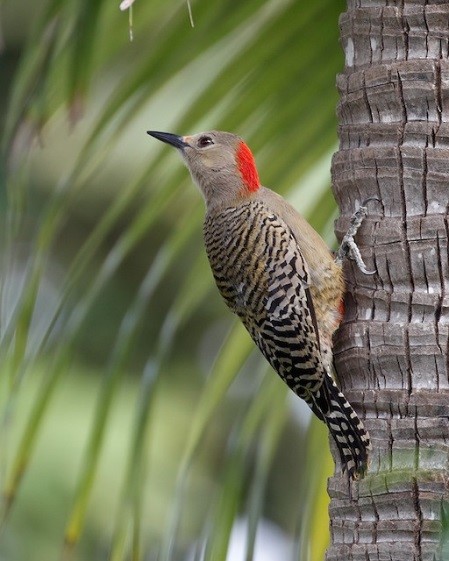Birdfinding.info ⇒ An insular form of West Indian Woodpecker that is common in its small range. Readily found at Botanic Park, the Mastic Trail, North Side, and generally across the eastern side of the island. Less numerous west of Bodden Town, but usually present at Barkers National Park, in West Bay and George Town neighborhoods, and sometimes in palm stands along Seven Mile Beach.
“Grand Cayman Woodpecker”
Melanerpes superciliaris caymanensis
Family: Picidae
Endemic to Grand Cayman, where it is common in wooded habitats throughout the island.
Identification
Very similar to the familiar Red-bellied Woodpecker of eastern North America, with approximately the same barred pattern on the back and wings, bright red crown, and reddish patch on the belly.
Differs from Red-bellied mainly in having narrower black bars and dull yellow-olive instead of white on the back and wing coverts, and a yellow-olive or smoky-gray tone on the underparts.
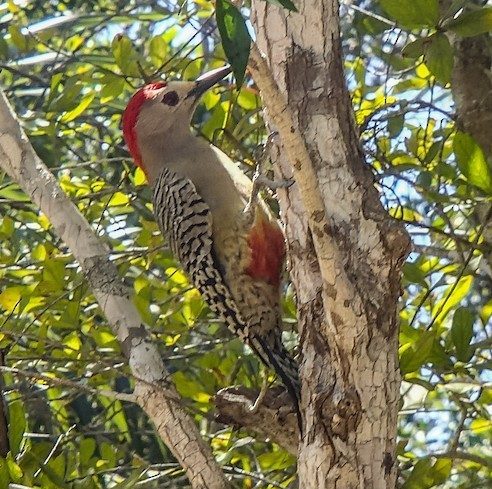
“Grand Cayman Woodpecker,” male showing reddish belly patch. (Queen Elizabeth II Botanic Park, Grand Cayman; March 6, 2014.) © Robert O’Connell

“Grand Cayman Woodpecker,” male showing smoky-gray tones on underparts and reddish spot at base of bill. (Queen Elizabeth II Botanic Park, Grand Cayman; May 21, 2017.) © Dany Garcia

“Grand Cayman Woodpecker,” male showing yellow-olive tones on back and underparts. (Queen Elizabeth II Botanic Park, Grand Cayman; October 15, 2018.) © Doug Gordon
The sexes are similar except that the female has red limited to the hindcrown and just a faint pink smudge on the belly. Both sexes sometimes have on orange or reddish spot on the feathers at the base of the upper mandible.
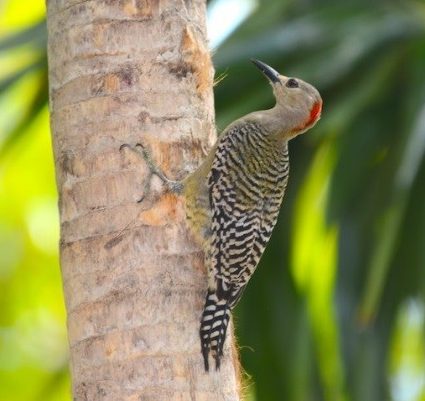
“Grand Cayman Woodpecker,” female showing yellow-olive tones. (North Side, Grand Cayman; March 19, 2013.) © Alan Van Norman
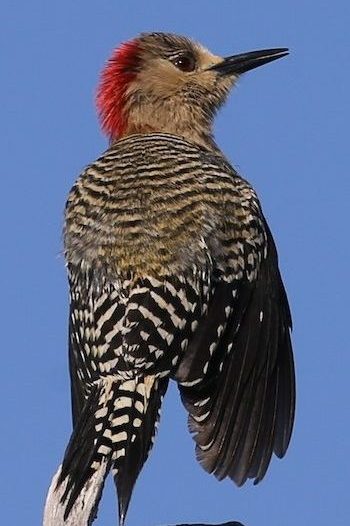
“Cayman Woodpecker,” female. (West Bay, Grand Cayman; March 27, 2016.) © Ceri James
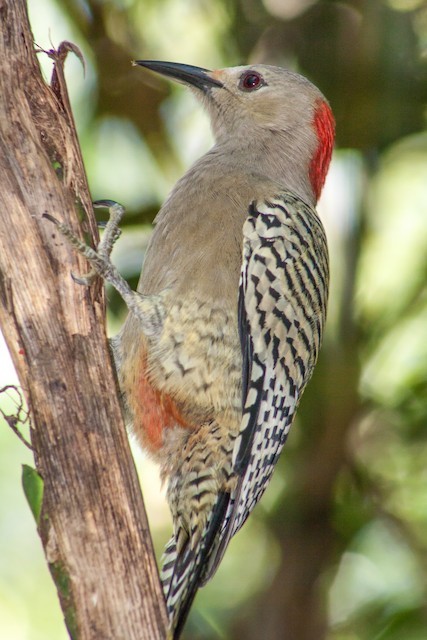
“Cayman Woodpecker,” female. (Queen Elizabeth II Botanic Park, Grand Cayman; November 17, 2014.) Anonymous eBirder

“Cayman Woodpecker,” female. (Queen Elizabeth II Botanic Park, Grand Cayman; November 17, 2014.) Anonymous eBirder
Notes
Monotypic form classified as a subspecies of West Indian Woodpecker.
Seems to be a likely candidate for recognition as a separate species, as the other subspecies of West Indian Woodpecker differ strongly in having bold black masks. Its classification as a subspecies seems inconsistent with current standards of species delineation.
References
eBird. 2019. eBird: An online database of bird distribution and abundance. Cornell Lab of Ornithology, Ithaca, N.Y. http://www.ebird.org. (Accessed January 14, 2019.)
Gorman, G. 2014. Woodpeckers of the World: A Photographic Guide. Firefly Books, London.
Raffaele, H., J. Wiley, O. Garrido, A. Keith, and J. Raffaele. 1998. A Guide to the Birds of the West Indies. Princeton University Press, Princeton, N.J.
Winkler, H., D.A. Christie. 2018. West Indian Woodpecker (Melanerpes superciliaris). In Handbook of the Birds of the World Alive (J. del Hoyo, A. Elliott, J. Sargatal, D.A. Christie, and E. de Juana, eds.). Lynx Edicions, Barcelona. https://www.hbw.com/node/56173. (Accessed November 4, 2018.)
